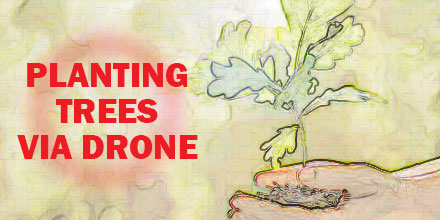Reforestation at Industrial Scale Possible Via Drone?
 A former NASA engineer is harnessing the potential of drone technology for a very ambitious project.
A former NASA engineer is harnessing the potential of drone technology for a very ambitious project.
The project? Ecosystem restoration.
More precisely, scaling reforestation projects to a size previously unimaginable.
The goal? Plant 1 billion trees every year…via drone.
Lauren Fletcher spent 20 years at NASA as an engineer before founding BioCarbon Engineering. The startup’s entire focus is reforestation. More precisely, reforestation via the use of drones.
BioCarbon Engineering plans to combat deforestation and restore global forests with a unique solution. Their platform takes the best data available and enables local specialists to restore their landscapes both quickly and affordably.
Industrial-scale Combating Clear-Cutting, 1 Billion Trees at a Time
Advancements in technology facilitated the large-scale harvesting of forests. Now, in a process known as clear cutting, acres of forests are harvested in a single day. Each year, it is estimated that clear-cutting is responsible for the disappearance of 26 billion trees around the world.
Reforesting such vast areas is a challenge.
The end result? Trees are cut down much quicker than they are replaced.
Industrial-scale deforestation around the world is threatening to upset the ecosystem’s balance. To combat the danger, reforestation projects continue to gain prominence.
Through various initiatives, many countries are actively working to replace trees.
Traditionally, reforestation is done by hand. On average, a single individual can plant 3000 seeds or saplings in a day. This method is labor intensive and time consuming which makes closing the gap on deforestation frustratingly slow.
BioCarbon Engineering believes technology holds the answer. Drone technology can speed up and improve the process of replanting trees. They hope to improve the replanting rate to a projected 36,000 plants per day…or 1 billion trees in a year.
Because terrains can vary, using drones to plant trees and regenerate forests is not meant to replace the human element, but complement it.
Reforestation via Drone?
BioCarbon’s plan? Modify consumer drones so they can plant seeds and tree saplings. But that’s just the start. What follows is a simple, yet clever way of using the drones to improve the speed and efficiency of replanting efforts.
First, drones fly over a potential site, take photographs and conduct an aerial surveys. The team then creates a 3D aerial map and a “seeding” plan suitable for the terrain.
The team developed specialized pods which contain germinated seeds packed in a nutrient-rich substance. These bio-degradable pods sustain and protect the young plant until it can take root.
The pods load into a pressurized canister aboard the drone and fire into the ground. Drones fly a path that is roughly 3-6 feet above the ground. The number of drones in operation depends on the size of the site.
BioCarbon estimates that just two drone pilots operating multiple UAVs can plant up to 36,000 saplings a day.
If successful, the company’s approach would significantly improve global reforestation efforts.
Replacing Tree Losses on a Massive Scale
Today, some of the highest rates of deforestation occur in Latin America, Brazil, Malaysia, and the Philippines. Additionally, parts of Africa face the same issue. This may explain why Fletcher and BioCarbon are targeting projects in South Africa and the Amazon jungle first.
In addition to improving reforestation efforts, drones can also access areas that are inaccessible to humans. Plus, BioCarbon believes this technology can help improve the overall health of local ecosystems. For example, pods can help spread various fungi and micro-organisms that improve soil quality as well as diversify the species of trees replanted in the forest.
The efforts of BioCarbon is another example of drone use for humanitarian purposes. The company’s goals align with the UN’s plan to restore up to 300 billion trees by the year 2030. And, tree planting drones may just bring that goal within reach.

